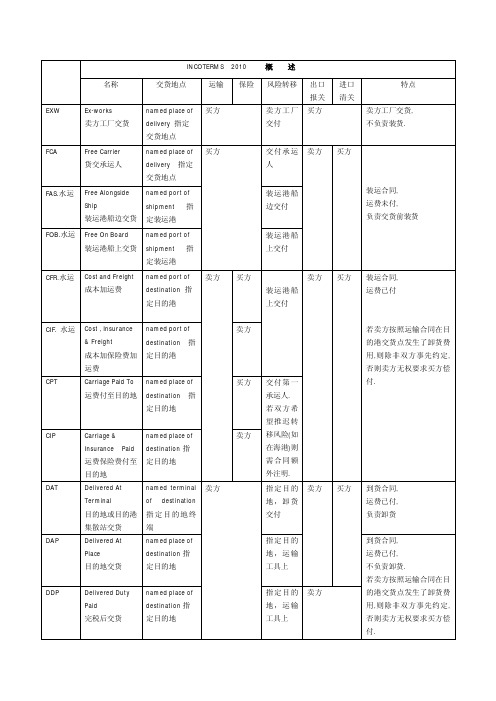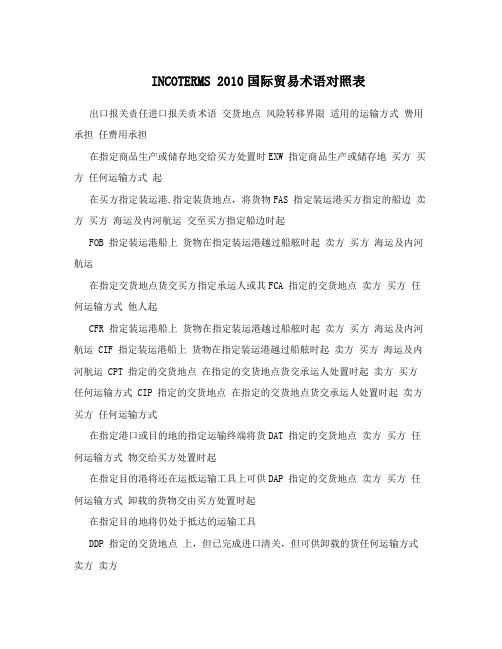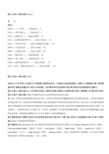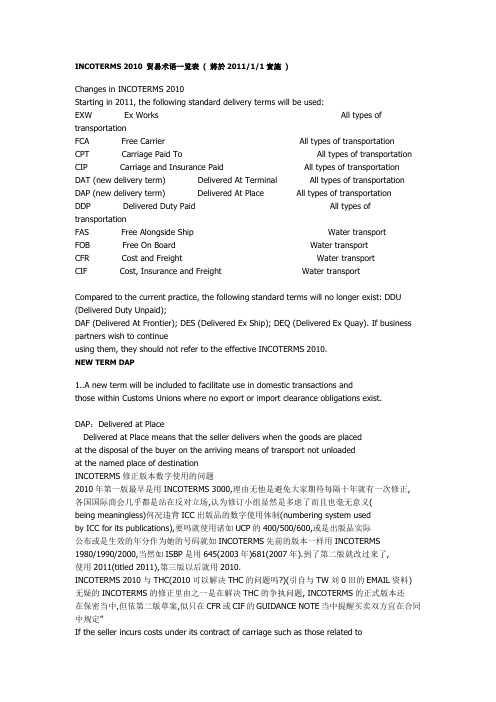incoterms 2010贸易术语比较表
(参考资料)国际贸易术语解释通则2010 一览表

成本加保险费加 定目的港
运费
CPT
Carriage Paid To named place of
运费付至目的地 destination 指
定目的地
CIP
Carriage &
named place of
Insurance Paid destination 指
运费保险费付至 定目的地
目的地
DAT
Delivered At
INCOTERMS 2010 概 述
名称
交货地点
运输 保险 风险转移 出口 进口
特点
报关 清关
EXW
Ex-works
named place of 买方
卖 方工 厂 买方
卖方工厂交货,
卖方工厂交货 delivery 指定
交付
不负责装货.
交货地点
FCA
Free Carrier
named place of 买方
运输与保险合同
运输与保险合同
A4 Delivery 交付货物
B4 Taking delivery 受领货物
A5 Transfer of risks 风险转移
A6 Allocation of costs 费用分摊
B5 Transfer of risks 风险转移
B6 Allocation of costs 费用分摊
货交承运人
delivery 指定
交货地点
FAS.水运
Free Alongside Ship 装运港船边交货
named port of shipment 指 定装运港
交 付承 运 卖方 买方 人
装运港船 边交付
装运合同, 运费未付, 负责交货前装货
Incoterms-2010-国际贸易术语中英文对照解释(全)

EXW (insert named place of delivery)GUIDANCE NOTEThis rule may be used irrespective of the mode of transport selected and may also be used where more than one mode of transport is employed.It is suitable for domestic trade, while FCA is usually more appropriate for international trade.“Ex Works” means that the seller delivers when it places the goods at the disposal of the buyer at the seller’s premises or a t another named place (i.e., works, factory, warehouse, etc.). The seller does not need to load the goods on any collecting vehicle, nor does it need to clear the goods for export, where such clearance is applicable.The parties are well advised to specify as clearly as possible the point within the named place of delivery, as the costs and risks to that point are for the account of the seller. The buyer bears all costs and risks involved in taking the goods from the agreed point, if any, at the named place of delivery.EXW represents the minimum obligation for the seller. The rule should be used with care as:a) The seller has no obligation to the buyer to load the goods, even though in practice the seller may be in a betterposition to do so. If the seller does load the goods, it does so at the buyer’s risk and expense. In cases where the seller i s in a better position to load the goods, FCA, which obliges the seller to do so at its own risk and expense, is usually more appropriate.b) A buyer who buys from a seller on an EXW basis for export needs to be aware that the seller has an obligation toprovide only such assistance as the buyer may require to effect that export: the seller is not bound to organize the export clearance. Buyers are therefore well advised not to use EXW if they cannot directly or indirectly obtain export clearance.c) The buyer has limited obligations to provide to the seller any information regarding the export of the goods. However,the seller may need this information for, e.g., taxation or reporting purposes.EXW——工厂交货(……指定地点)本条规则与(当事人)所选择的运输模式无关,即便(当事人)选择多种运输模式,亦可适用该规则。
INCOTERMS2010国际贸易术语对照表

INCOTERMS 2010国际贸易术语对照表出口报关责任进口报关责术语交货地点风险转移界限适用的运输方式费用承担任费用承担在指定商品生产或储存地交给买方处置时EXW 指定商品生产或储存地买方买方任何运输方式起在买方指定装运港.指定装货地点,将货物FAS 指定装运港买方指定的船边卖方买方海运及内河航运交至买方指定船边时起FOB 指定装运港船上货物在指定装运港越过船舷时起卖方买方海运及内河航运在指定交货地点货交买方指定承运人或其FCA 指定的交货地点卖方买方任何运输方式他人起CFR 指定装运港船上货物在指定装运港越过船舷时起卖方买方海运及内河航运 CIF 指定装运港船上货物在指定装运港越过船舷时起卖方买方海运及内河航运 CPT 指定的交货地点在指定的交货地点货交承运人处置时起卖方买方任何运输方式 CIP 指定的交货地点在指定的交货地点货交承运人处置时起卖方买方任何运输方式在指定港口或目的地的指定运输终端将货DAT 指定的交货地点卖方买方任何运输方式物交给买方处置时起在指定目的港将还在运抵运输工具上可供DAP 指定的交货地点卖方买方任何运输方式卸载的货物交由买方处置时起在指定目的地将仍处于抵达的运输工具DDP 指定的交货地点上,但已完成进口清关,但可供卸载的货任何运输方式卖方卖方物交由买方处置时起INCOTERMS 2010的四组贸易术语工厂交货EXW Ex Works,…named place of delivery, E组,起运,货交承运人FCA Free Carrier,…named place of delivery,F组船边交货 FAS Free A longside Ship,…named port of shipment, ,主要运费未付, 船上交货FOB Free on Board,…named port of shipment, 成本加运费CFR Cost and Freight ,…named port of destination ,成本,保险费加运费CIF Cost, Insurance and Freight,…named port of destination, C组运费付至 CPT 运费,保险费付至 ,主要运费已付, CIP Carriage Paid to,…named place of destination ,Carriage, and Insurance Paid to,…named place of destination,运输终端交货DAT Delivered At Terminal,…named terminal at port or placeD组 of destination, 目的地交货 ,到达, DAP Delivered AtPlace ,…named place of destin ation, 完税后交货 DDP Delivered Duty Paid ,…named place of destination,。
INCOTERMS 2010 国际贸易术语

INCOTERMS2010《國際貿易術語解釋通則》(以下稱Incoterms)的宗旨是為國際貿易中最普遍使用的貿易術語提供一套解釋的國際規則,以避免因各國不同解釋而出現的不確定性,或至少在相當程度上減少這種不確定性。
合同雙方當事人之間互不瞭解對方國家的貿易習慣的情況時常出現。
這就會引起誤解、爭議、和訴訟,從而浪費時間和費用。
為解決這些問題,國際商會(ICC)於1936年首次公佈了一套解釋貿易術語的國際規則,名為Incoterms1936,隔幾年就會出個修訂版,目前最新的是第八版國貿條規Incoterms2010。
這些規則是因應當前國際貿易發展而制定。
TheIncotermsrulesorInternationalCommercialtermsareaseriesofpre-definedcommercialtermspublishedb海運和內陸河運適用的規則∙FAS船邊交貨∙FOB船上交貨∙∙∙∙∙∙∙∙∙注:使用這個國際貿易術語通則時要加上地方。
例如EXWYiwuChina,FOBShangHaiChinaEXW–ExWorks-(namedplaceofdelivery)工廠交貨(......指定地點)Thebuyerbearsallcostsandrisksinvolvedintakingthegoodsfromtheseller'spremisestothedesireddestinatio n.Theseller'sobligationistomakethegoodsavailableathispremises(works,factory,warehouse).Thistermrepr esentsminimumobligationfortheseller.Thistermcanbeusedacrossallmodesoftransport.EXW是國際貿易術語之一,可以用在所有的交通工具。
Incoterms2010贸易术语

3. 均可适用于国际贸易和国内贸易 主要适用于欧盟等自由贸易区内国家交易需要; 4. 电子通讯的发展 电子通讯与书面通讯具有相同效力 5. 保险承保范围 伦敦保险业协会“协会货物保险条款”2009年修订 6. 与安全有关的通关及相关所需信息 要求检定货物不会因除其自身属性外的原因而造成对生命
CIP的卖方须办理货物运输保险,支付保险费,卖方在合同规定的 装运港/地将货物交付至船上或承运人,即履行了交货义务。 按C组术语成交的合同,也属装运合同(Shipment Contract)。
26
4、D 组――DAT、DAP、DDP
按D组术语成交的合同,属到达/到货合同 (Arrival contract)。
出口国--------------------------------进口国
(卖方工厂所在地)
(买方工厂所在地)
(三)贸易术语的作用
节省交易磋商的时间和费用; 简化交易磋商的内容和合同的内容; 避免争议的发生; 有助于国际贸易的开展。
10
二、有关贸易术语的国际惯例
( 一 ) 《1932 年 华 沙 ―― 牛 津 规 则 》 ( WarsawOxford Rules,简称W.O.Rules 1932) 该规则对CIF贸易术语作了解释。
贸易术语的分组――E、F、C、D四组
1、E组――EXW
按E组术语成交的合同属启运合同/发货合同 (Departure contract);
按E组术语成交,卖方在自已的地点(工厂、仓库等所在 地)为买方备妥货物,即在其工厂、仓库所在地将货物交 付至买方即履行了交货义务。
23
2、F组――FCA、FAS 、FOB F组术语,称主运费未付术语(MAIN
of transport) 3. D组术语调整 4. 术语内容调整(transport documents) 5. 结构调整(introduction & guidance note) 6. 部分义务分配和文字表述调整
(完整版)Incoterms-2010-国际贸易术语中英文对照解释(全)

EXW (insert named place of delivery)GUIDANCE NOTEThis rule may be used irrespective of the mode of transport selected and may also be used where more than one mode of transport is employed.It is suitable for domestic trade, while FCA is usually more appropriate for international trade.“Ex Works” means that the seller delivers when it places the goods at the disposal of the buyer at the seller’s premises or a t another named place (i.e., works, factory, warehouse, etc.). The seller does not need to load the goods on any collecting vehicle, nor does it need to clear the goods for export, where such clearance is applicable.The parties are well advised to specify as clearly as possible the point within the named place of delivery, as the costs and risks to that point are for the account of the seller. The buyer bears all costs and risks involved in taking the goods from the agreed point, if any, at the named place of delivery.EXW represents the minimum obligation for the seller. The rule should be used with care as:a) The seller has no obligation to the buyer to load the goods, even though in practice the seller may be in a betterposition to do so. If the seller does load the goods, it does so at the buyer’s risk and expense. In cases where the seller i s in a better position to load the goods, FCA, which obliges the seller to do so at its own risk and expense, is usually more appropriate.b) A buyer who buys from a seller on an EXW basis for export needs to be aware that the seller has an obligation toprovide only such assistance as the buyer may require to effect that export: the seller is not bound to organize the export clearance. Buyers are therefore well advised not to use EXW if they cannot directly or indirectly obtain export clearance.c) The buyer has limited obligations to provide to the seller any information regarding the export of the goods. However,the seller may need this information for, e.g., taxation or reporting purposes.EXW——工厂交货(……指定地点)本条规则与(当事人)所选择的运输模式无关,即便(当事人)选择多种运输模式,亦可适用该规则。
2010年国际贸易术语解释通则(INCOTERMS 2010)

适用于任何单一运输方式或多种运输方式的术语EXW (EX works) 工厂交货FCA (Free Carrier) 货交承运人CPT (Carriage Paid To) 运费付至CIP (Carriage and lnsurance Paid to) 运费、保险费付至DAT (Delivered At Terminal) 运输终端交货DAP (Delivered At Place) 目的地交货DDP (Delivered Duty Paid) 完税后交货适用于海运和内河水运的术语FAS (Free Along Side) 船边交货FOB (Free On Board) 船上交货CFR (Cost and Freight) 成本加运费CIF (Cost, Insurance and Freight) 成本、保险加运费(EX Works工厂交货)该术语可适用于任何运输方式,也可适用于多种运输方式。
它适合国内贸易,而FCA一般则更适合国际贸易。
“工厂交货”是指当卖方在其所在地或其它指定地点(如工厂、车间或仓库等)将货物交由买方处置时,即完成交货。
卖方不需将货物装上任何前来接收货物的运输工具,需要清关时,卖方也无需办理出口清关手续。
特别建议双方在指定交货地范围内尽可能明确具体交货地点,因为在货物到达交货地点之前的所有费用和风险都由卖方承担。
买方则需承担自此指定交货地的约定地点(如有的话)收取货物所产生的全部费用和风险。
EXW(工厂交货)术语代表卖方最低义务,使用时需注意以下问题:a) 卖方对买方没有装货的义务,即使实际上卖方也许更方便这样做。
如果卖方装货,也是由买方承担相关风险和费用。
当卖方更方便装货物时,FCA一般更合适,因为该术语要求卖方承担装货义务,以及与此相关的风险和费用。
b) 以EXW为基础购买出口产品的买方需要注意,卖方只有在买方要求时,才有义务协助办理出口,即卖方无义务安排出口通关。
因此,在买方不能直接或间接地办理出口清关手续时,不建议使用该术语。
国际贸易术语解释通则(INCOTERMS2010)

国际贸易术语解释通则(2010)目录前言. 1EXW——工厂交货(……指定地点). 5FCA——货交承运人(……指定地点). 7CPT——运费付至(……指定目的港). 10CIP——运费和保险费付至(……指定目的地)13DAT——终点站交货(……指定目的港或目的地)16DAP——目的地交货(……指定目的地). 18DDP——完税后交货(……指定目的地). 20FAS——船边交货(……指定装运港). 22FOB——船上交货(……指定装运港). 24CFR——成本加运费付至(……指定目的港)27CIF——成本,保险加运费付至(……指定目的港)30国际贸易术语解释通则2010全球化经济赋予商业以空前宽广途径通往世界各地市场。
货物得以在更多的国家、大量且种类愈繁地销售。
然而随着全球贸易数额的增加与贸易复杂性的提升,因销售合同不恰当起草引致误解与高代价争端可能性也提高了。
国际贸易术语解释通则这一用于国内与国际贸易事项的国际商会规则使得全球贸易行为更便捷。
在销售合同中参引国际贸易术语解释通则2010可清晰界定各方义务并降低法律纠纷的风险。
自1936年国际商会创制国际贸易术语以来,这项在全球范围内普遍被接受的合同标准经常更新,以保持与国际贸易发展步调一致。
国际贸易术语解释通则2010版考虑到了全球范围内免税区的扩展,商业交往中电子通讯运用的增多,货物运输中安保问题关注度的提高以及运输实践中的许多变化。
国际贸易术语解释通则2010更新并加强了“交货规则”——规则的总数从13降到11,并为每一规则提供了更为简洁和清晰的解释。
国际贸易术语解释通则2010同时也是第一部使得所有解释对买方与卖方呈现中立的贸易解释版本。
国际商会商法和实践委员会成员来自世界各地和所有贸易领域,该委员会宽泛的专业技能确保了国际贸易术语解释通则2010与各地的商贸需要照应。
国际商会向Fabio Bortolotti(意大利)的商法和实践委员会的成员表示谢意,向由Charles Debattista(副组长,英国),Christoph Martin Radtke (副组长,法国),Jens Bredow (德国),Johnny Herre (瑞典),David Lwee(英国),Lauri Railas (芬兰),Frank Reynold(美国),Miroslav Subert (捷克)组成的起草小组致谢,并且向对11条规则的表述给予帮助的Asko Raty (芬兰)致谢。
11个国际贸易术语比较

11个国际贸易术语比较《INCOTERMS 2010》国际贸易术语中11个贸易术语如下:第一组:适用于任何运输方式的术语七种:EXW、FCA、CPT、CIP、DAT、DAP、DDP。
EXW(ex works)工厂交货FCA(free carrier)货交承运人CPT(carriage paid to)运费付至目的地CIP(carriage and insurance paid to)运费/保险费付至目的地DAT(delivered at terminal)目的地或目的港的集散站交货DAP(delivered at place)目的地交货DDP(delivered duty paid)完税后交货第二组:适用于水上运输方式的术语四种:FAS、FOB、CFR、CIF。
FAS(free alongside ship)装运港船边交货FOB(free on board)装运港船上交货CFR(cost and freight)成本加运费CIF(cost insurance and freight)成本、保险费加运费拓展资料:贸易术语(Trade Terms)也被称为价格术语(Price Terms),是在长期的国际贸易实践中产生的,用来表示成交价格的构成和交货条件,确定买卖双方风险、责任、费用划分等问题的专门用语。
主要作用:1.有利于买卖双方洽商交易和订立合同。
由于每一种贸易术语对买卖双方的义务都有统一的解释,有利于买卖双方明确各自的权利和义务,早日成交。
2.有利于买卖双方核算价格和成本。
各种贸易术语对于成本、运费和保险费等各项费用由谁负担都有明确的界定,买卖双方比较容易核算价格和成本。
3.有利于解决履约当中的争议。
由于贸易术语由相关的国际惯例解释,对买卖双方在交易中的争议,可通过国际贸易惯例解释。
Incoterms2010国际贸易术语解释通则2010(中文版)

Incoterms2010国际贸易术语解释通则2010(中文版) Incoterms2010国际贸易术语解释通则2010(中文版)引言Incoterms2010,即国际贸易术语解释通则2010,是国际商会(ICC)制定的贸易术语标准。
这一标准的目的是为国际贸易中的买卖双方提供一套共同理解的贸易术语,以便在交货、运输和分担风险等方面达成一致。
术语分类Incoterms2010将贸易术语分为四大类:1. E类术语(Departure):货物离开卖方处时,卖方完成了他的责任;2. F类术语(Mn carriage not pd by seller):卖方将货物交给运输人员后,卖方完成了他的责任;3. C类术语(Mn carriage pd by seller):卖方负责预付运费,但风险转移给买方的时间是在货物交给第一运输人员之前;4. D类术语(Arrival):卖方负责交货并将货物交给买方指定的目的地。
主要术语解释以下是几个Incoterms2010中的主要术语解释:EXW(卖方工厂交货)EXW即“ex works”的缩写,意为卖方工厂交货。
在EXW术语下,卖方只需将货物准备好并交于买方指定的地点,买方负责所有的运输和保险手续。
FOB(装运港价格)FOB即“free on board”的缩写,意为装运港价格。
在FOB术语下,卖方将货物交于指定的装运港口,并承担货物装载到船上的费用和风险。
一旦货物装上船,责任就转移给买方。
CIF(到岸价、保险费付至目的港)CIF即“cost, insurance and freight”的缩写,意为到岸价、保险费付至目的港。
在CIF术语下,卖方负责将货物交至目的港口,并承担货物运输和保险费用直到目的港口。
DDP(交货完税价)DDP即“delivered duty pd”的缩写,意为交货完税价。
在DDP术语下,卖方负责将货物交至买方指定的目的地,并承担货物在目的地的所有费用和风险,包括关税和税费。
INCOTERMS2010中文版

INCOTERMS2010中文版INCOTERMS 2010中文版1. 介绍INCOTERMS(国际贸易术语解释规则)是由国际商会(ICC)制定的国际贸易术语规则,用于明确买卖双方在国际货物运输中的责任和义务。
INCOTERMS 2010是由于全球贸易环境的变化而发布的最新版本,共有11个术语,用于规范国际货物交易的常用术语和惯例。
2. EXW(装货港交货)EXW意味着卖方将货物放置在指定的地点,由买方负责所有的运输安排和费用。
在这种术语下,卖方的义务非常有限,买方需要承担所有的进口手续、装卸费用和风险。
3. FCA(运费或运输人接收处交货)FCA表示卖方将货物交给指定的运输人或承运人。
卖方负责将货物交到指定地点,并承担出口清关手续。
买方需要负责进口清关手续、运输保险和费用。
4. CPT(运费支付到目的地)CPT意味着卖方负责将货物运输到目的地,并承担货物运输费用直到目的地。
买方需要负责货物的进口清关手续、保险费用和未列入卖方义务的其他费用。
5. CIP(运费和保险费支付到目的地)CIP与CPT类似,唯一的区别是卖方还需要承担货物运输保险费用。
买方需要负责货物的进口清关手续和未列入卖方义务的其他费用。
6. DAT(到岸价)DAT意味着卖方负责将货物交付到指定目的港口,并承担货物的进口清关手续和支付关税。
买方需要承担货物的卸载费用和将货物送到目的地的费用。
7. DAP(交货地点)DAP表示卖方负责将货物交付到约定的目的地,买方需要承担货物的进口清关手续、卸货费用和将货物送到目的地的费用。
8. DDP(已交税承担)DDP意味着卖方承担所有的责任和费用,包括货物运输、保险、清关和将货物交付到买方指定的目的地。
9. FAS(船上交货)FAS表示卖方将货物交交付给指定的港口,并承担将货物装上船的费用和风险。
买方需要负责运输、装卸费用和风险。
10. FOB(船上交货)FOB意味着卖方负责将货物交付给指定的港口,并承担将货物装上船的费用和风险。
国际贸易术语表(INCOTERMS2010)总结

卖方
买方
卖方
买方
海运或内河水运
指卖方在船上交货或以取得已经这样交付的货物方式交货。CFR价=FOB价+F运费
CIF
Cost Insurance and Freight
成本、保险费加运费(插入指定目的港)
指定的装运港口
货物交到船上时
卖方
卖方
卖方
买方
海运或内河水运
指在装运港当货物越过船舷时卖方即完成交货。CIF价=FOB价+I保险费+F运费,俗称"到岸价"
相对2000通则,2010通则主要有以下变化。
(1)13种贸易术语变为11种;
(2)贸易术语分类由四级变为两类;
(3)使用范围的扩大至国内贸易合同;
(4)电子通信方式被2010通则赋予完全等同的功效。
虽然2010通则于2011年1月1日正式生效,但并非2000通则就自动作废。因为国际贸易惯例本身不是法律,对国际贸易当事人不产生必然的强制性约束力。国际贸易惯例在适用的时间效力上并不存在"新法取代旧法"的说法,即2010通则实施之后并非2000通则就自动废止,当事人在订立贸易合同时仍然可以选择适用2000通则甚至1990通则。
出口国的地点或港口
承运人或运输代理人处置货物后
买方
买方
卖方
买方
任何运输方式或多式联运
指卖方在其所在地或其他指定地点将货物交给买方指定的承运人或其他人
FOB
Free on Board
船上交货(插入指定装运港)
指定的装运港口
货物交到船上时
买方
买方
卖方
买方
海运或内河水运
指卖方以在指定装运港将货物装上买方指定的船舶或通过取得已交付至船上货物的方式交货
2010年新《国际贸易术语解释通则》-Incoterms 2010-新变化

2010年新《国际贸易术语解释通则》-Incoterms 2010-新变化发表时间:2011-04-10 21:34:00 阅读次数: 1195 所属分类:国际贸易法[转]国际商会正式发布国际贸易术语解释通则20102010年9月27日,国际商会ICC在巴黎召开国际贸易术语解释通则20 10全球发布会,正式推出其于近期刚刚完成修订的Incoterms 2010。
这标志着被经贸界使用了近十年的Incoterms即将被新版本所取代。
新版本将于201 1年1月1日正式生效。
Incoterms® 2010与Incoterms 2000的关系:虽然Incoterms 2010 将于2011年1月1日正式生效,但是Incoter ms2010实施之后并非Incoterms 2000就自动作废。
因为国际贸易惯例本身不是法律,对国际贸易当事人不产生必然的强制性约束力。
国际贸易惯例在适用的时间效力上并不存在“新法取代旧法”的说法,即2010实施之后并非2000就自动废止,当事人在订立贸易合同时仍然可以选择适用Incoterms 2000甚至Incote rms 1990。
外贸人员应该学习掌握Incoterms 2010新的规则。
但是,外贸人也无须过于担忧。
首先,贸易一线的人员没有必要担忧,未来的两三年Incoterms 2000仍然会是贸易合同的主角;法律界的法官、律师们更无须担忧,Incoterms 201 0纠纷两三年之后才会大量出现。
但是司法考试的同学们明年要特别注意了,因为不出意外的话明年司法考试的大纲会将Incoterms 2010列为司考内容。
Incoterms 2010主要变化:1. 术语分类的调整:由2原来的EFCD 四组分为适用于两类:适用于各种运输方式和水运2、贸易术语的数量由原来的13种变为11种。
3、删除INCOTERMS2000中四个D组贸易术语,即DDU (Delivered Duty Unpaid)、DAF (Delivered At Frontier)、 DES (Delivered Ex Ship)、 DEQ (Delivered Ex Quay),只保留了INCOTERMS2000D组中的DDP(Delivered Duty Paid )。
Incoterms-2010-国际贸易术语中英文对照解释(全)

EXW (insert named place of delivery)GUIDANCE NOTEThis rule may be used irrespective of the mode of transport selected and may also be used where more than one mode of transport is employed.It is suitable for domestic trade, while FCA is usually more appropriate for international trade.“Ex Works” means that the seller delivers when it places the goods at the disposal of the buyer at the seller’s premises or a t another named place (i.e., works, factory, warehouse, etc.). The seller does not need to load the goods on any collecting vehicle, nor does it need to clear the goods for export, where such clearance is applicable.The parties are well advised to specify as clearly as possible the point within the named place of delivery, as the costs and risks to that point are for the account of the seller. The buyer bears all costs and risks involved in taking the goods from the agreed point, if any, at the named place of delivery.EXW represents the minimum obligation for the seller. The rule should be used with care as:a) The seller has no obligation to the buyer to load the goods, even though in practice the seller may be in a betterposition to do so. If the seller does load the goods, it does so at the buyer’s risk and expense. In cases where the seller i s in a better position to load the goods, FCA, which obliges the seller to do so at its own risk and expense, is usually more appropriate.b) A buyer who buys from a seller on an EXW basis for export needs to be aware that the seller has an obligation toprovide only such assistance as the buyer may require to effect that export: the seller is not bound to organize the export clearance. Buyers are therefore well advised not to use EXW if they cannot directly or indirectly obtain export clearance.c) The buyer has limited obligations to provide to the seller any information regarding the export of the goods. However,the seller may need this information for, e.g., taxation or reporting purposes.EXW——工厂交货(……指定地点)本条规则与(当事人)所选择的运输模式无关,即便(当事人)选择多种运输模式,亦可适用该规则。
《INCOTERMS 2010》三种常用贸易术语的变化及其应用

《INCOTERMS 2010》三种常用贸易术语的变化及其应用关于《INCOTERMS 2010》颁布后,对其与前一版本(《INCOTERMS2000》)的比较文章有不少,大多从INCOTERMS 整体内容上作出分析和比较,鲜有针对具体贸易术语的应用做比较分析,特别是对有的贸易术语内容理解上还存在着偏差。
本文以常用的三种贸易术语———FOB、CFR和CIF 为例,通过案例分析和比较,对这三种贸易术语在《INCOTERMS2010》和前一版本的具体应用变化作了深入的探讨,希望能够更加深刻地理解贸易术语的内容及正确解决应用问题。
一、FOB《INCOTERMS 2000》对FOB的规定:“船上交货(…指定装运港)”,是指货物在指定的装运港越过船舷,卖方即完成交货。
这意味着买方必须从该点起承担一切费用和货物灭失或损坏的一切风险。
《INCOTERMS 2010》对FOB的规定:“船上交货(…指定装运港)”,是指货物在指定的装运港装上买方指派的船上,卖方即完成交货或者卖方获取如此交付的货物(适用链式销售———作者注)。
风险在货物装上船舶时由卖方转移至买方,并在此时刻开始时买方承担所用费用。
新规则对FOB规定的变化具体体现为两方面:(一)风险转移界限与卖方交货义务完成的统一。
变化前,《INCOTERMS2000》将FOB 风险转移的界限界定为装运港货物越过船舷,但卖方交货义务(A4)规定在指定日期和指定装运港,将货物装上买方指定的船只上。
这样规定对实际业务操作中判定货物在装运过程中的损失可能带来争议,争议的基本焦点就是何时为越过船舷?而越过船舷之后是否就意味着货物已经装上船?变化后,《INCOTERMS 2010》中的FOB 改变了在对风险转移界限以“船舷为界”的描述,取而代之的是明确规定货物在卖方按照规定的交货义务(A4)完成时风险由卖方转移至买方。
这样规定把风险转移的界限和卖方交货义务完成的时间统一起来,现实应用中减少操作上的偏差和理解上的争议。
2010通则

CFR+I=CIF
FOB+F+I= CIF
FOB、CFR、CIF与FCA、CPT、CIP比较图
不同
FOB、CFR、CIF
FCA、CPT、CIP
运输方式
内河及海洋运输
各种
交货地点
出口国港口
出口国内地或港口
风险转移时间
货物交至装运港船上时
货已交承运人时
主运费已付/装运合同
出口国仓库、车站、机场、CY/CFS或码头
当地要装异地不卸承运人运输工具
货交第一承运人
卖方
买方
卖方
买方
各运
CIF
Cost, Insurance and Freight(named port of destination)
成本加保险费运费(指定目的港)
主运费已付/装运合同
装运港
装上指定船舶
各运
DAT
DELIVERED AT TERMINAL (named terminal at port or place of destination)
运输终端交货(指定港口或目的地的运输终端)
到达/到货合同
目的港、地的承运人运输终端
要从运输工具上卸下
抵达目的地卸下交由买方处置时
卖方
卖方
卖方
买方
各运
DAP
船边交货(……指定装运港)
船上交货(……指定装运港)
C组:卖方必须订立装运合同,但对交运后所交生的风险,不承担责任
CFR
CIF
CPT
CIP
成本加运费(……指定目的港)
成本、保险费加运费(……指定目的地)
运费付至(……指定目的地)
INCOTERMS 2010 国际贸易术语一览表 0.1版

序号贸易术语英文全称中文全称后缀1EXW Ex Works工厂交货
2FCA Free Carrier货交承运人
3CPT Carriage Paid To运费付至
4CIP Carriage and Insurance Paid to运费,保险费付至
5DAT Delivered At Terminal运输终端交货
6DAP Delivered At Place目的地交货
7DDP Delivered Duty Paid完税后交货
8FAS Free Along Side船边交货
9FOB Free On board船上交货
10CFR Cost and Freight成本加运费11CIF Cost, Insurance and Freight成本保险加运费目的港
INCOTER
装运地
目的地
装运港
运输方式
交货地点风险转移界限商品产地、所在地买方处置货物后指定目的港或目的地的运输终端上货交买方后(卸货)买方处置货物后 (未卸货)
买方在指定地点收货后
水运进口国内
出口国内地、港口
*C组交货地点与后缀地点不同,运费付至目的地,货运至装运港/地。
其余交货地点与后缀地点一致。
装运港口货交装运港船上后
承运人处置货物后
OTERMS 2010贸易术语一览表
任何
运输费用
保险费用
出口报关
进口报关
买方
卖方
卖方
卖方
卖方买方
买方
买方
卖方
买方卖方
买方买方
卖方。
INCOTERMS 2010 贸易术语一览表

INCOTERMS 2010 贸易术语一览表( 將於2011/1/1實施)Changes in INCOTERMS 2010Starting in 2011, the following standard delivery terms will be used:EXW Ex Works All types of transportationFCA Free Carrier All types of transportationCPT Carriage Paid To All types of transportation CIP Carriage and Insurance Paid All types of transportation DAT (new delivery term) Delivered At Terminal All types of transportation DAP (new delivery term) Delivered At Place All types of transportationDDP Delivered Duty Paid All types of transportationFAS Free Alongside Ship Water transportFOB Free On Board Water transportCFR Cost and Freight Water transportCIF Cost, Insurance and Freight Water transportCompared to the current practice, the following standard terms will no longer exist: DDU (Delivered Duty Unpaid);DAF (Delivered At Frontier); DES (Delivered Ex Ship); DEQ (Delivered Ex Quay). If business partners wish to continueusing them, they should not refer to the effective INCOTERMS 2010.NEW TERM DAP1..A new term will be included to facilitate use in domestic transactions andthose within Customs Unions where no export or import clearance obligations exist.DAP:Delivered at PlaceDelivered at Place means that the seller delivers when the goods are placedat the disposal of the buyer on the arriving means of transport not unloadedat the named place of destinationINCOTERMS修正版本数字使用的问题2010年第一版最早是用INCOTERMS 3000,理由无他是避免大家期待每隔十年就有一次修正, 各国国际商会几乎都是站在反对立场,认为修订小组显然是多虑了而且也毫无意义(being meaningless)何况违背ICC出版品的数字使用体制(numbering system usedby ICC for its publications),要吗就使用诸如UCP的400/500/600,或是出版品实际公布或是生效的年分作为她的号码就如INCOTERMS先前的版本一样用INCOTERMS1980/1990/2000,当然如ISBP是用645(2003年)681(2007年).到了第二版就改过来了,使用2011(titled 2011),第三版以后就用2010.INCOTERMS 2010与THC(2010可以解决THC的问题吗?)(引自与TW刘0田的EMAIL资料) 无疑的INCOTERMS的修正里由之一是在解决THC的争执问题, INCOTERMS的正式版本还在保密当中,但依第二版草案,似只在CFR或CIF的GUIDANCE NOTE当中提醒买卖双方宜在合同中规定”If the seller incurs costs under its contract of carriage such as those related tounloading or handling at the specified point at the port of destination agreed in the sale contract, the seller is not entitled to recover such costs from the buyerunless otherwise agreed between the part ies”似乎也无法解决目地港THC的问题.PS:日本贸易实务界人士星野清在其所著[TRADE TERMS雑感」一文中说,由于中国的货代(FORWARDER)揽货过度的竞争,会压低运费再向日本买方征收诸如EBS(EmergencyBunker Surcharge)或YAS(Yen Appreciation Surcharge)等名目的附加费用.19 October 2010Article by Stephen Tricks and Hatty SumptionThe Incoterms rules are internationally recognised standardised terms reflecting business practice in the allocation of tasks,costs and risks in international sales contracts. The ICC has just published the latest version of these rules, Incoterms 2010.The new rules are relevant for those involved in the buying and selling of goods, especially trading companies, exportersand importers, together with those involved in associated services including marine, multimodal transport, logistics andfinancial services.The new Incoterms 2010 rules enter into force on 1 January 2011. This update outlines the main changes introduced inthe new rules.BackgroundIncoterms have been devised and published by the International Chamber of Commerce (ICC) since 1936. The aim of theRules is to facilitate the conduct of global trade by providing clear definitions of the parties' respective obligations, therebyreducing the risk of legal complications.The latest version replaces the 2000 edition and is the culmination of a lengthy process of drafting and consultation involving over 30 national committees and several key trade bodies. The extensive comment and response process resulted in theproduction of three consultation drafts leading up to the final version of Incoterms 2010. The Incoterms 2010 rules take account of changes in transport practice, together with the spread of customs-free zones,increased use of electronic communication and security issues.The Key Changes:•Consolidation of 'D' TermsThe following rules have been abolished:DAF – Delivered At FrontierDES – Delivered Ex ShipDEQ – Delivered Ex QuayDDU – Delivered Duty UnpaidThe DDP rule (Delivered Duty Paid) is unchanged and is joined by the following new 'D' rules:DAT – Delivered At TerminalThis is intended to replace DEQ with terms more suitable for container transportation. The terms provide for deliverywhen goods are unloaded from the arriving means of transport and are placed at the disposal of the buyer at thenamed terminal. An example would be where a container has been unloaded from a ship and placed in the containerstack at the port of delivery(?destination?).DAP – Delivered At PlaceThis replaces DES, DAF and DDU and provides for delivery on the arriving means of transport, ready for unloading. Anexample of likely use would be for delivery by truck to the buyers' premises, or delivered by ship to a named port, notunloaded or import cleared.•Terminal Handling ChargesThe Incoterms 2010 rules seek to clarify the allocation of terminal handling costs between the parties. This is in response to difficulties that have arisen where such costs, although sometimes included in the carriage costs paid by the buyer, havenevertheless been charged to the buyer by the carrier or terminal operator. The new rules are intended to reduce therisk of the buyer being charged twice for terminal handling costs.•InsuranceMinor changes have been made in Incoterms 2010 to those rules that require a party to obtain insurance (CIF and CIP).It is important to note that Incoterms 2010 still requires the seller to obtain only the minimum cover under InstituteCargo 'C' Clauses, or equivalent, on a CIF or CIP transaction. In many cases, the buyer will want to include in the contractan express requirement for the more extensive Institute Cargo 'A' Clauses. For other terms, there are new provisionsrequiring the parties to exchange information regarding insurance.•Electronic CommunicationIncoterms 2000 provided that certain specified documents could be replaced with Electronic Data Interchange (EDI)messages where the parties agreed to do so. Incoterms 2010 now allow for paper communication to be replaced withan 'equivalent electronic record or procedure' where the parties so agree or where customary.The reference to customis significant as it means that in certain cases parties will be unable to refuse electronic communication, such as email.•SecurityHeightened international concern about security has resulted in increased clearance requirements relating to the movement of goods. In response, Incoterms 2010 includes provisions that allocate responsibility for obtaining or assisting to obtainclearances between the buyer and seller.•String SalesIn the sale of commodities it is common for cargo to be sold, perhaps several times, during transit. Incoterms 2000 included obligations for a seller to 'ship' the goods but this did not accurately reflect the position of a seller in the middle of a string of transactions who was unable to 'ship' goods that had already been shipped by the first seller. Incoterms 2010 now provides an option, where relevant, to allow the seller to procure goods that have been shipped as an alternative to the obligationto ship the goods.•Domestic and International TradeAlthough Incoterms have traditionally been used in international sale contracts, the ICC has noted that in certain parts ofthe world trade blocs (such as the EU) have made border formalities between different countries less significant. Inaddition, there has also been a greater trend towards using Incoterms for purely domestic sale contracts, including in theUnited States. With this in mind, Incoterms 2010 formally recognises that the rules are available for both domestic andinternational sale contracts and, where appropriate, the rules state that the obligation to comply with export / importformalities exists only where applicable.•General Pointso The Incoterms 2010 rulebook has been reorganised into two classes;'RULES FOR ANY MODE OR MODES♣ OF TRANSPORT' and'RULES FOR SEA AND INLAND WATERWAY♣ TRANSPORT'For rules included in the second class, the point of delivery and the place to which the goods are carried are both ports.FAS, FOB, CFR and CIF all belong to this class. The first class contains the remaining seven Incoterms.o All reference to the 'ship's rail' as the point of delivery has been removed from Incoterms 2010. Instead for FOB, CFR and CIF sales, goods are deemed delivered when they are 'on board' the vessel.o Incoterms 2010 includes clearer guidance notes. These do not form part of the rules but are intended toencourage use of the most appropriate Incoterms rule for any given transaction.CommentIncoterms 2010 introduce changes that reflect developments in international trade practice and regulation and as such are\ to be welcomed. The new rule book also includes improvements in organisation and guidance information that will beappreciated by users. However, it is essential to note that, as ever, the usefulness of the rules is largely dependent upon the parties selecting the correct Incoterms rule for any given transaction and in ensuring that the rules are properly incorporated into the sales contract. Even when the rule has been selected and incorporated correctly, attention must alsobe paid to ensuring that other relevant contracts (such as letters of credit, contracts of carriage and insurance) reflect the agreed terms.Finally, parties should always be aware that Incoterms 2010 are not comprehensive and that even where Incoterms ruleshave been properly incorporated, there are additional key provisions that will remain to be agreed by the parties.。
- 1、下载文档前请自行甄别文档内容的完整性,平台不提供额外的编辑、内容补充、找答案等附加服务。
- 2、"仅部分预览"的文档,不可在线预览部分如存在完整性等问题,可反馈申请退款(可完整预览的文档不适用该条件!)。
- 3、如文档侵犯您的权益,请联系客服反馈,我们会尽快为您处理(人工客服工作时间:9:00-18:30)。
CFR EX Tackle
CFRExShip’s Hold
卖方
买方
卖方
买方
CIF
成本加保险费、运费
CostInsurance
and Freight(后接进口国指定目的港)
装运
合同/象征性交货
出口国指定装运港
卖方在指定装运港将货物装上船
出口国装运港船上
主运费已付
指定目的港(术语变形可改变卸货费用负担)
门到FreeCarrier
(后接出口国指定装运地点)
装运
合同/
象征性交货
卖方所在地或出口国其他指定地点
在卖方所在地交货,卖方负责将货装上买方指定运输工具;非卖方所在地交货,卖方将货运到指定地点无需卸货,交由承运人处置
货交承运人
货交承运人
主运费未付
买方
买方
卖方
买方
CPT
运费付至
CIF liner Terms
CIF landed
CIF Ex Tackle
CIF Ex Ship’s Hold
卖方
卖方
卖方
买方
FOBUnderTackle
FOBStowed
FOB Trimmed
FOBST
买方
买方
卖方
买方
CFR
成本加运费
Cost and
Freight(后接进口国指定目的港)
装运
合同/象征性交货
出口国指定装运港
卖方在指定装运港将货物装上船
出口国装运港船上
主运费已付
指定目的港(术语变形可改变卸货费用负担)
CFRLiner Terms
Carriage Paid To(后接进口国指定目的地)
装运
合同/象征性交货
卖方所在地或出口国其他指定地点
同上
货交承运人
指定目的地
主运费已付
卖方
买方
卖方
买方
CIP
运费、保险费付至Carriage and Insurance Paid To
(后接进口国指定目的地)
装运
合同/象征性交货
卖方所在地或出口国其他指定地点
到达
合同/实际
交货
合同指定目的地
在指定目的地货物仍处于抵达的运输工具上,卖方做好卸载准备
卖方将货物交给买方控制时
卖方将货物交
给买方控制时
卖方
卖方
卖方
卖方
FAS
装运港船边交货Free
AlongsideShip(后接出口国指定装运港)
装运
合同/象征性交货
出口国指定装运港
卖方将货物交到买方所派船只的旁边,而不需要负责装船
给买方控制时
卖方
卖方
卖方
买方
DAP
目的地交货
DeliveredAt
Place(后接进口国指定目的地)
到达
合同/实际
交货
合同指定目的地
在指定目的地货物仍处于抵达的运输工具上,卖方做好卸载准备
卖方将货物交给买方控制时
卖方将货物交
给买方控制时
卖方
卖方
卖方
买方
DDP
完税后交货
DeliveredDutyPaid(后接进口国指定目的地)
货交船边后
货交船边后
主运费未付
买方
买方
卖方
买方
海运和内河水
上运输方式
FOB
装运港船上交货Free on
Board(后接出口国指定装运港)
装运
合同/象征性交货
出口国指定装运港
卖方在指定装运港将货物交至买方指定的船上
出口国装运港船上
主运费未付
出口国装运港船上(术语变形可改变装货费用负担)
FOB Liner Terms
国际代码
名称
合同
性质
交货地点
交货运输状态
风险划分
费用划分
可因术语变形而改变
运输
责任
费用
保险
责任
费用
出口
报关
进口
报关
适合运输方式
EXW
工厂交货
Ex Works
产地
交货
合同
卖方所在地的车间、工厂仓库等
卖方不负责将货物装上买方准备的交通工具
卖方所在地,买方控制货物时
卖方所在地
买方
买方
买方
买方
任何
运输
方式
或
同上
货交承运人
指定目的地
主运费已付
卖方
卖方
卖方
买方
DAT
运输终端交货
DeliveredAt
Terminal(后接进口国指定目的港或目的地)
到达
合同/实际
交货
合同指定目的港或目的地的约定运输终端
在指定目的港或目的地的约定运输终端,卖方将货物从抵达的运输工具上卸下交给买方处置
卖方将货物交给买方控制时
卖方将货物交
